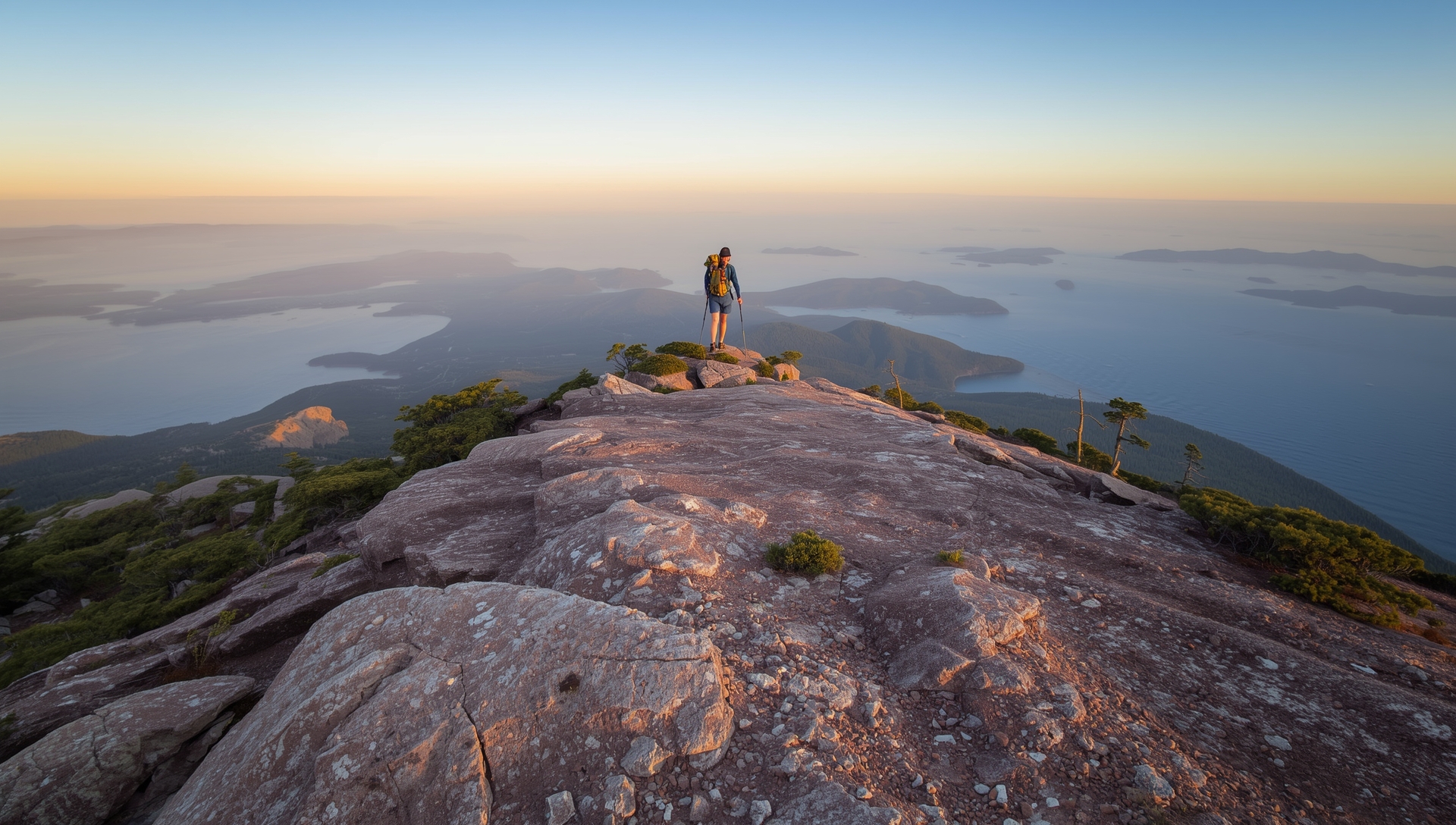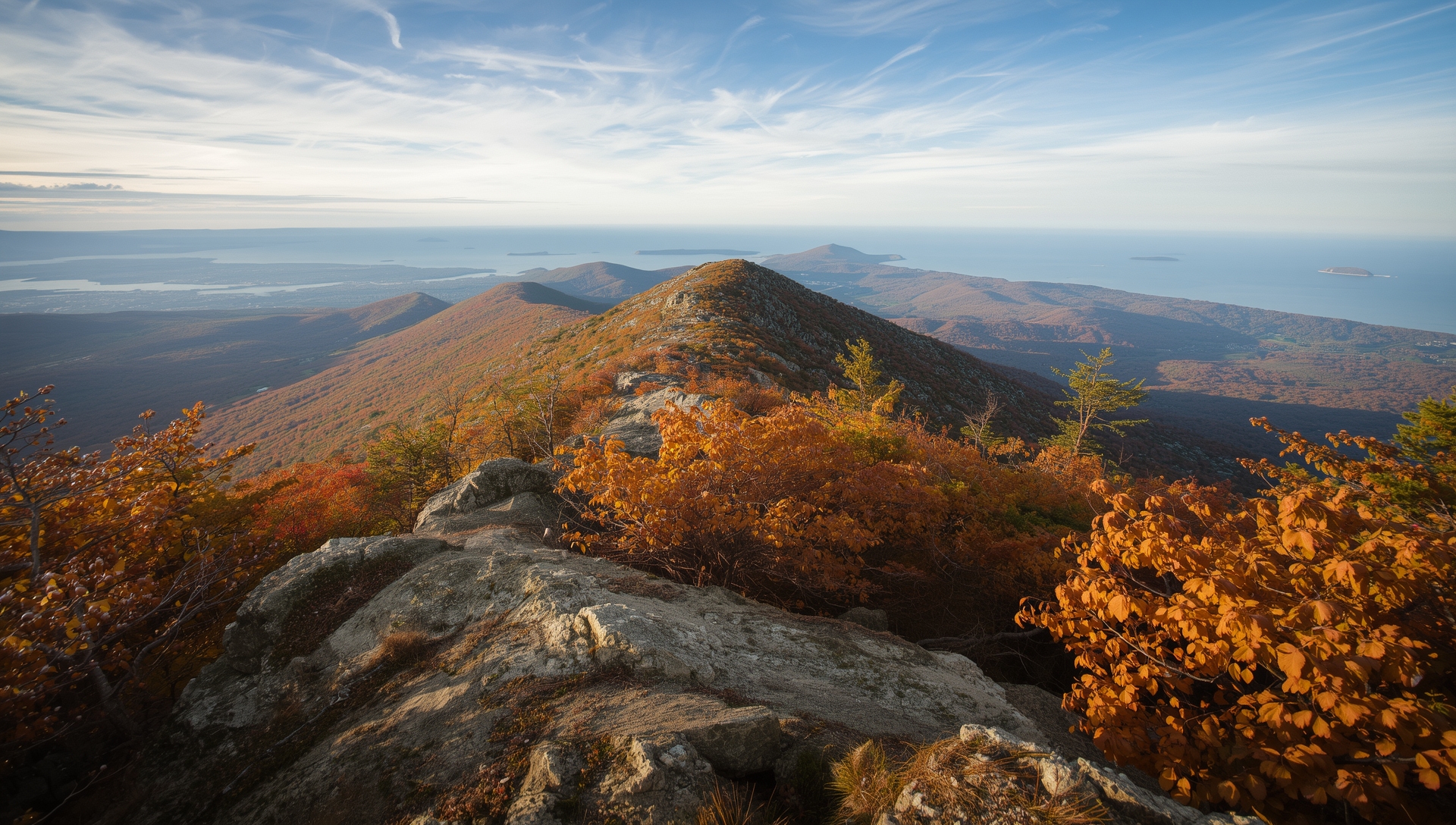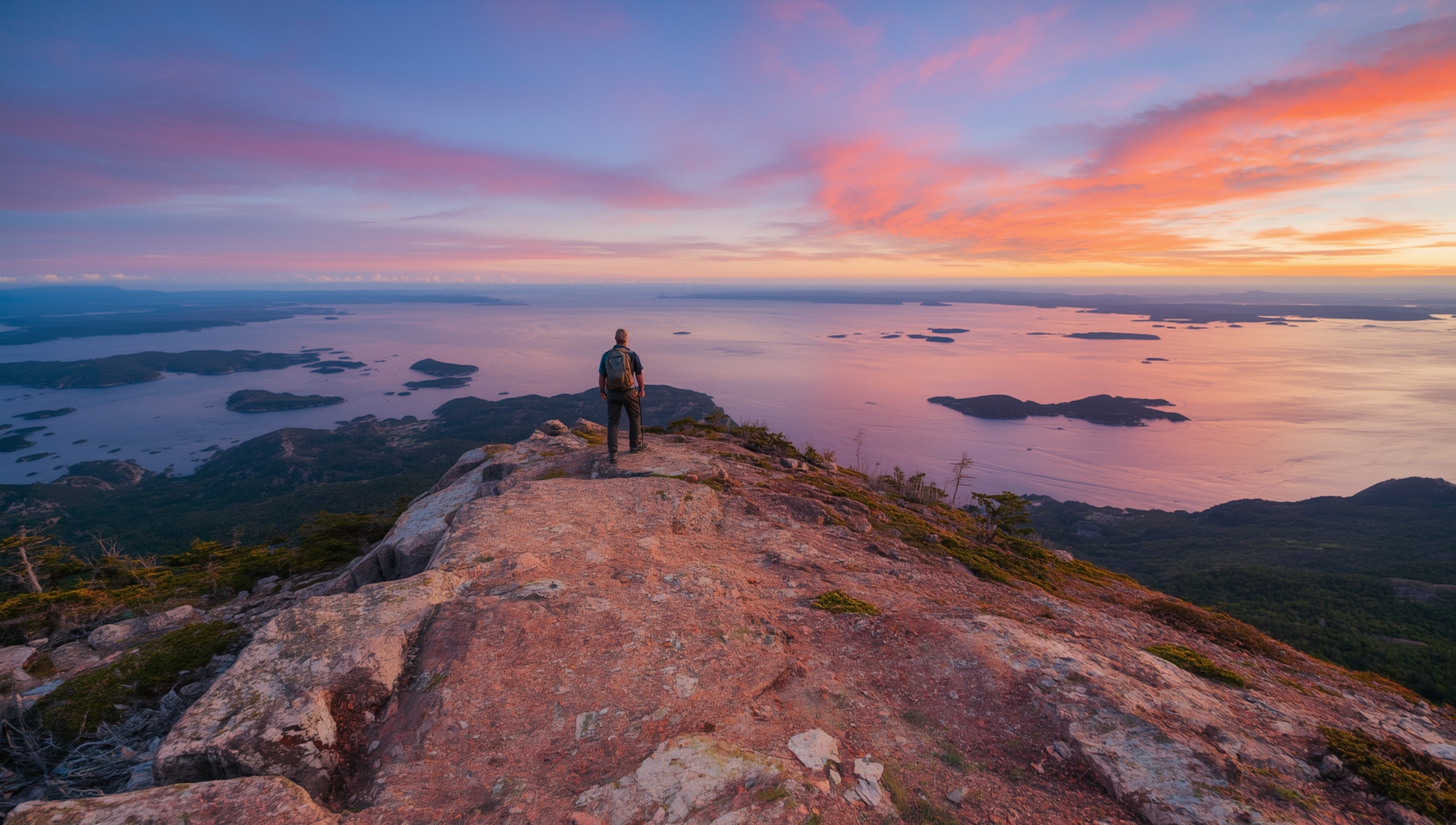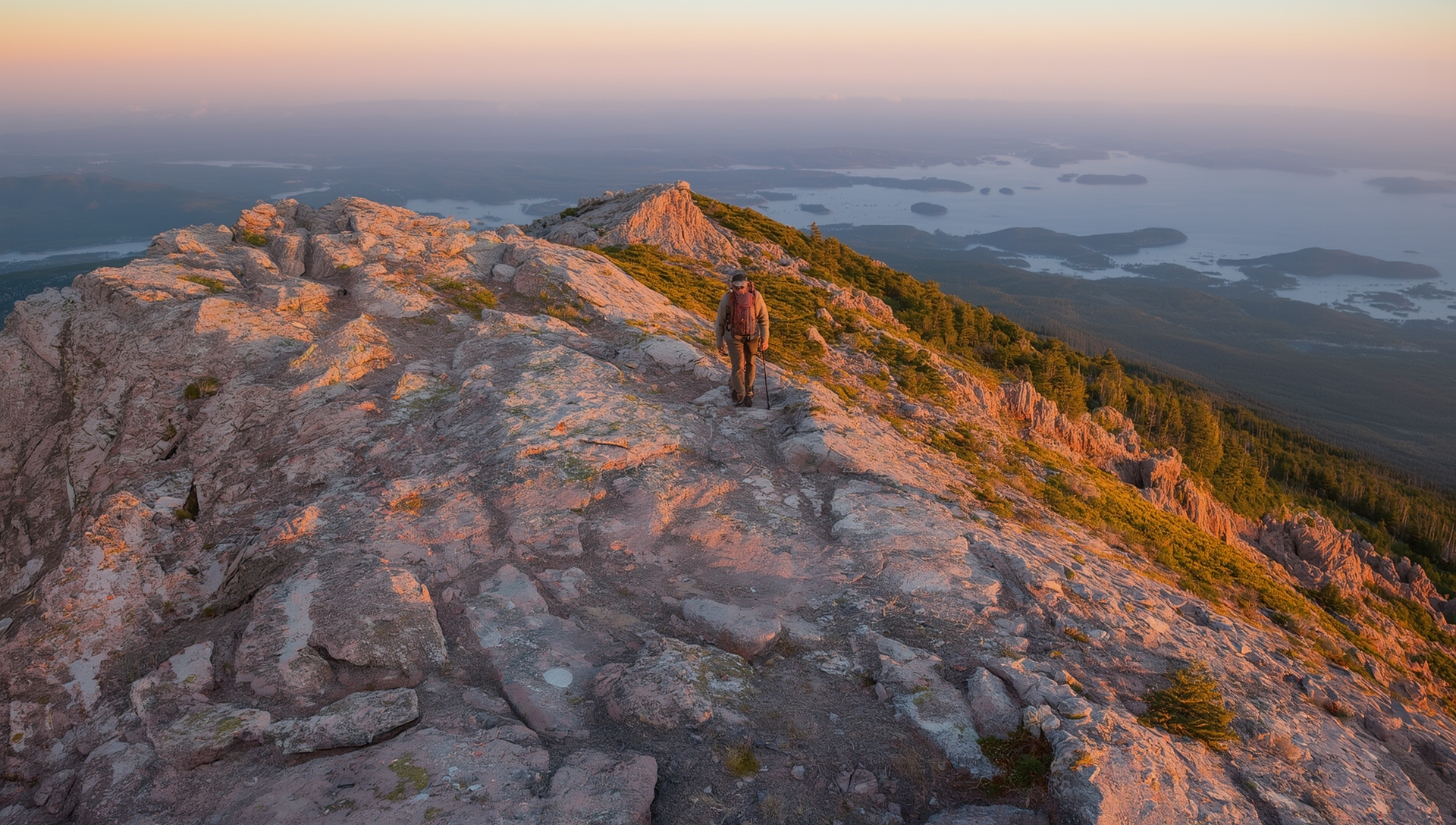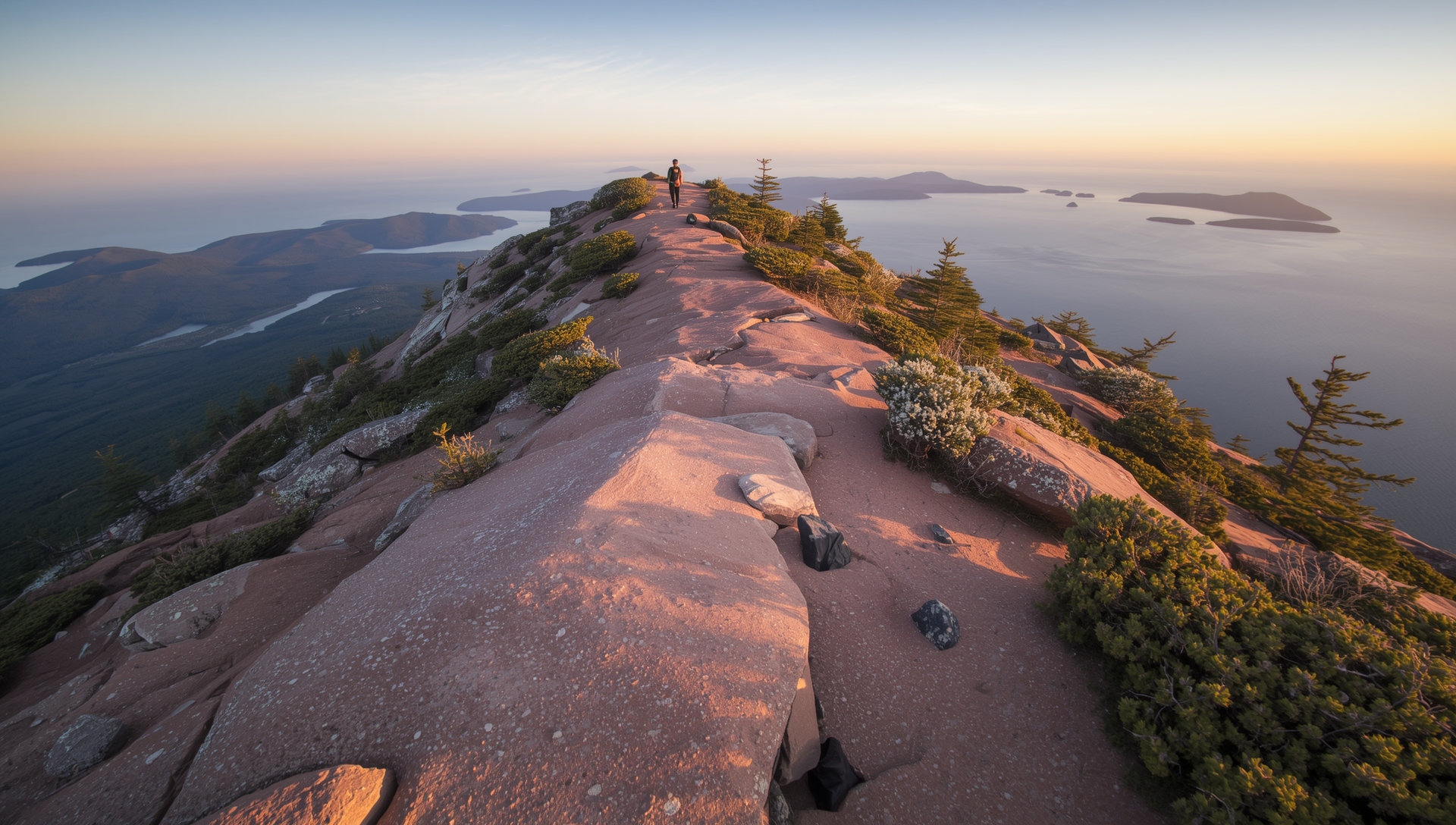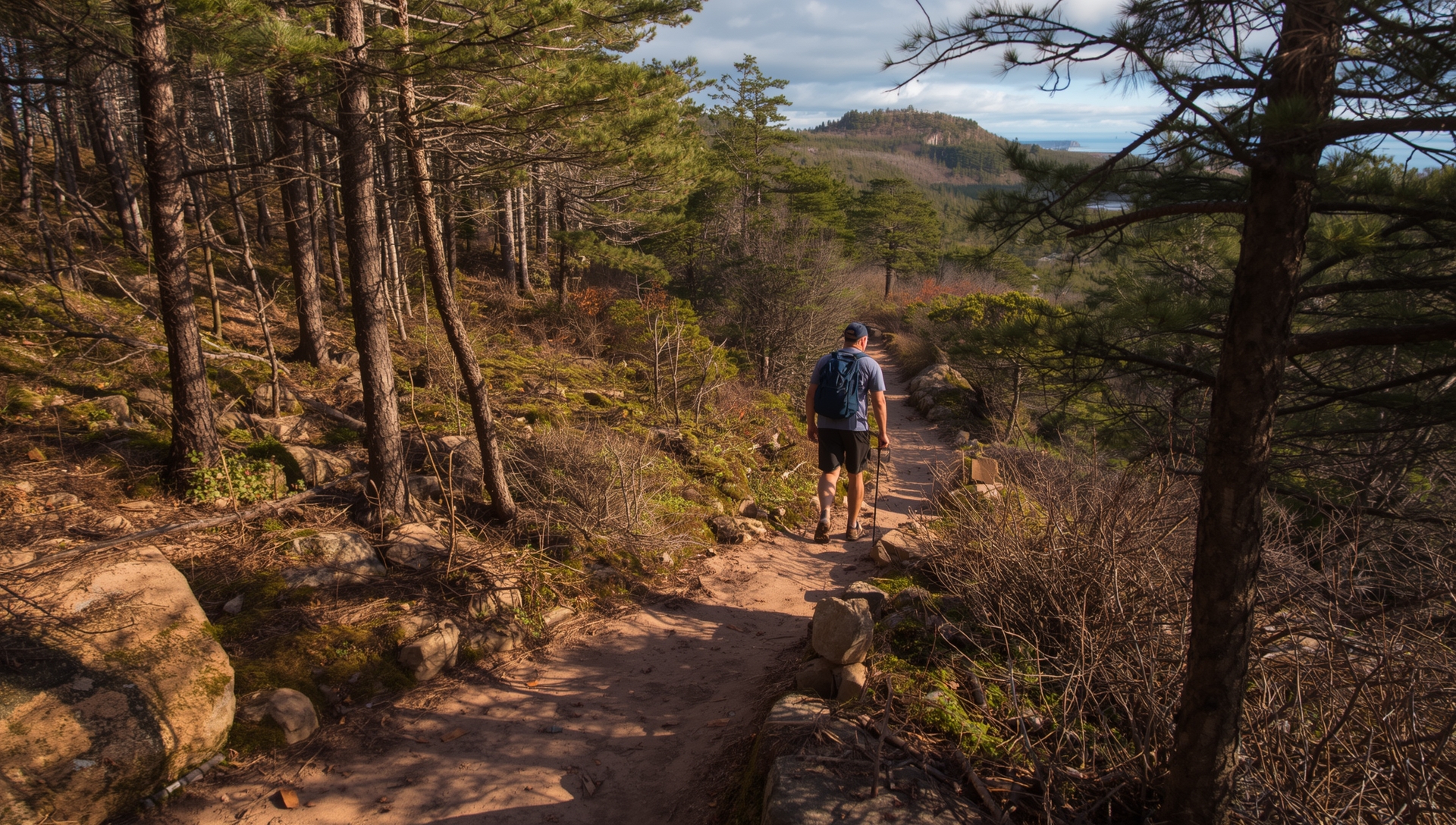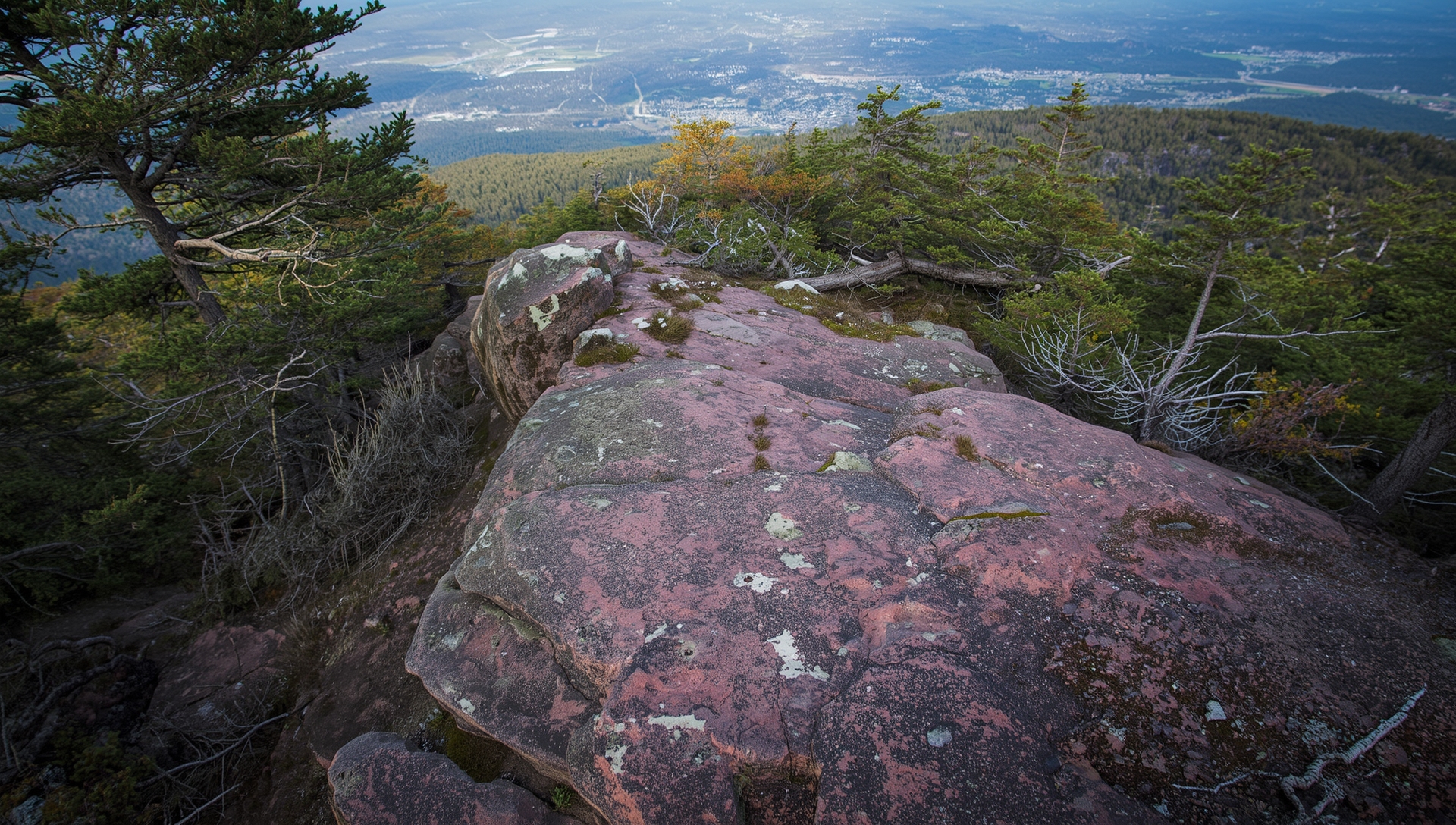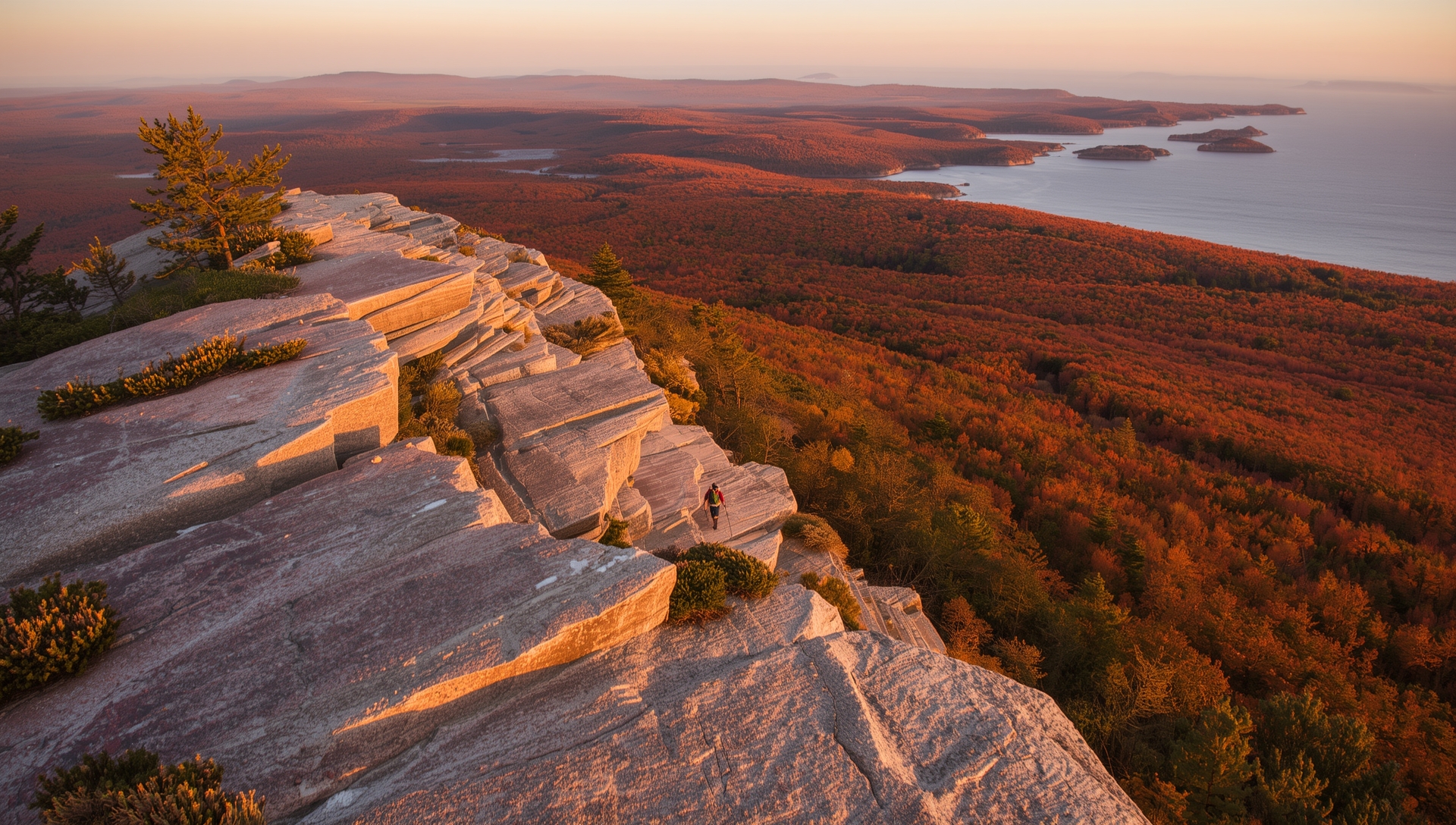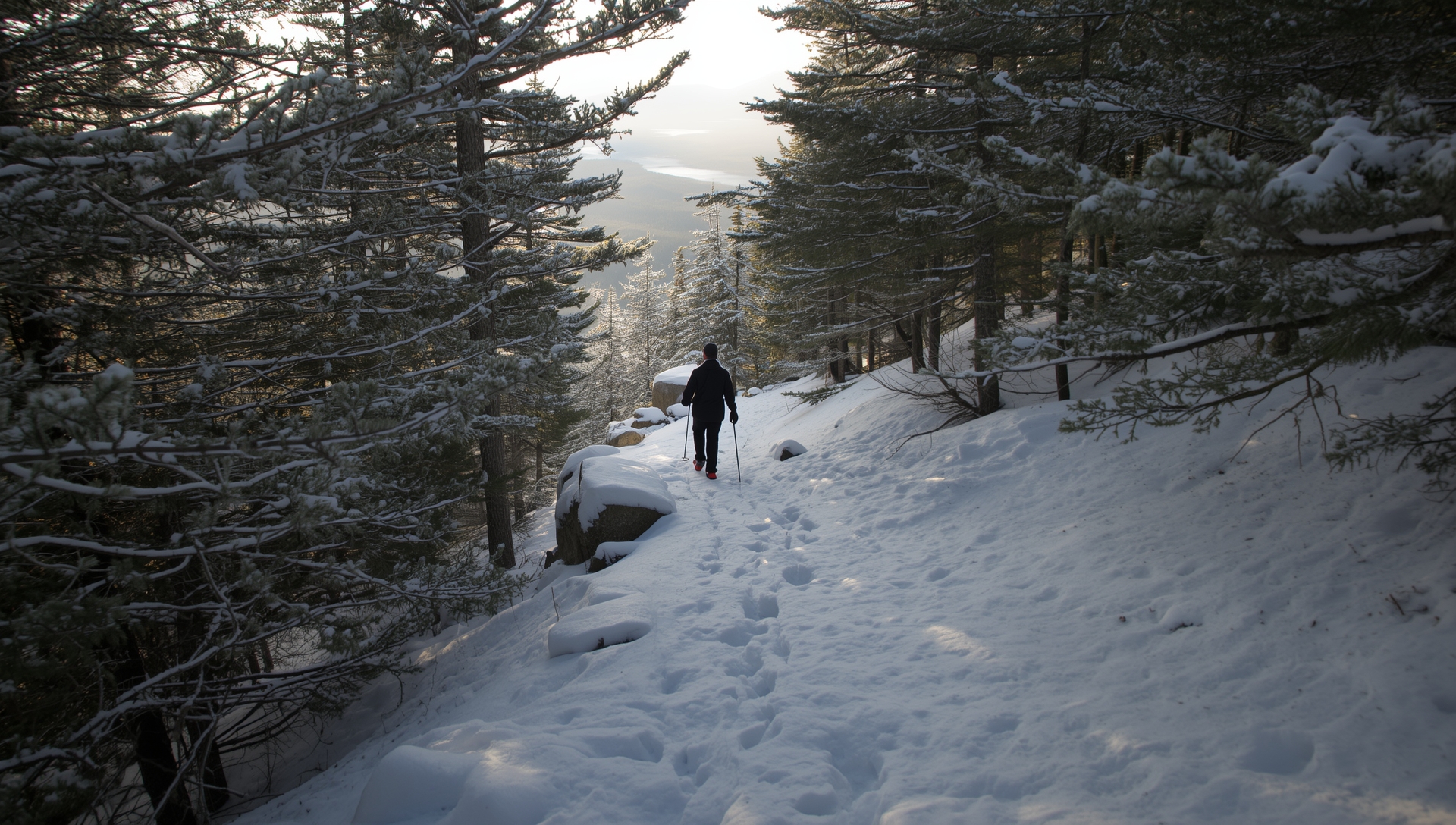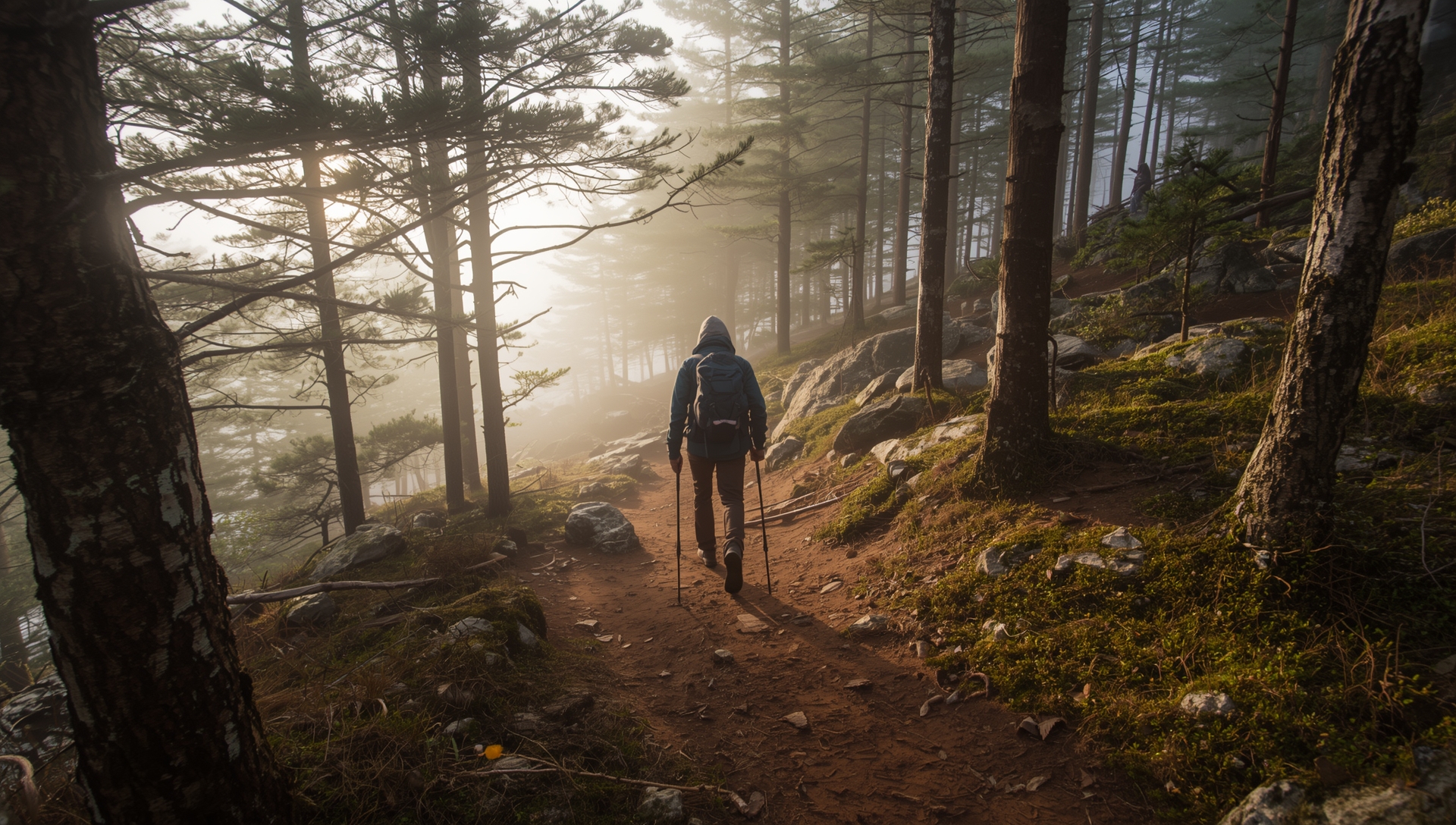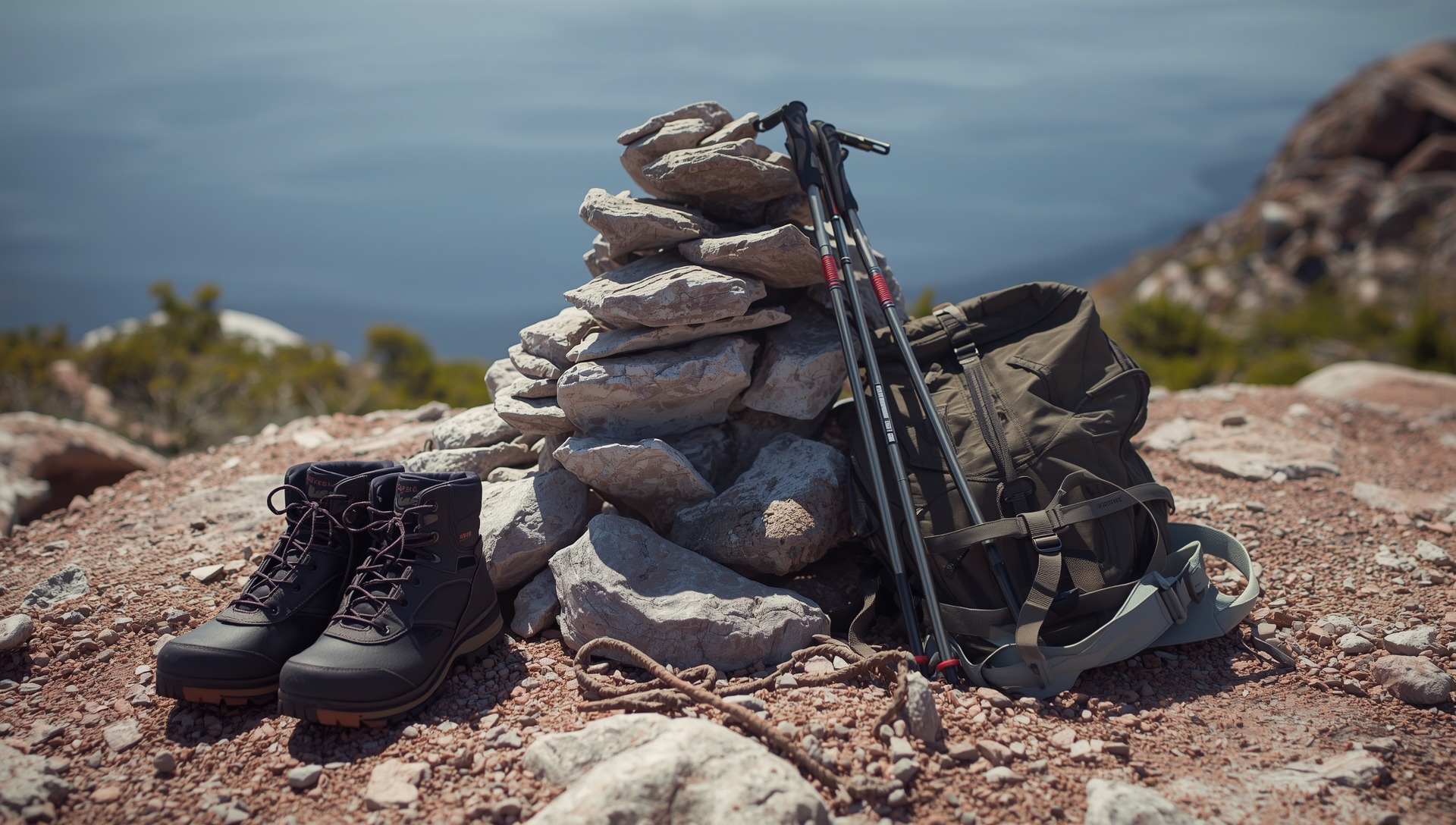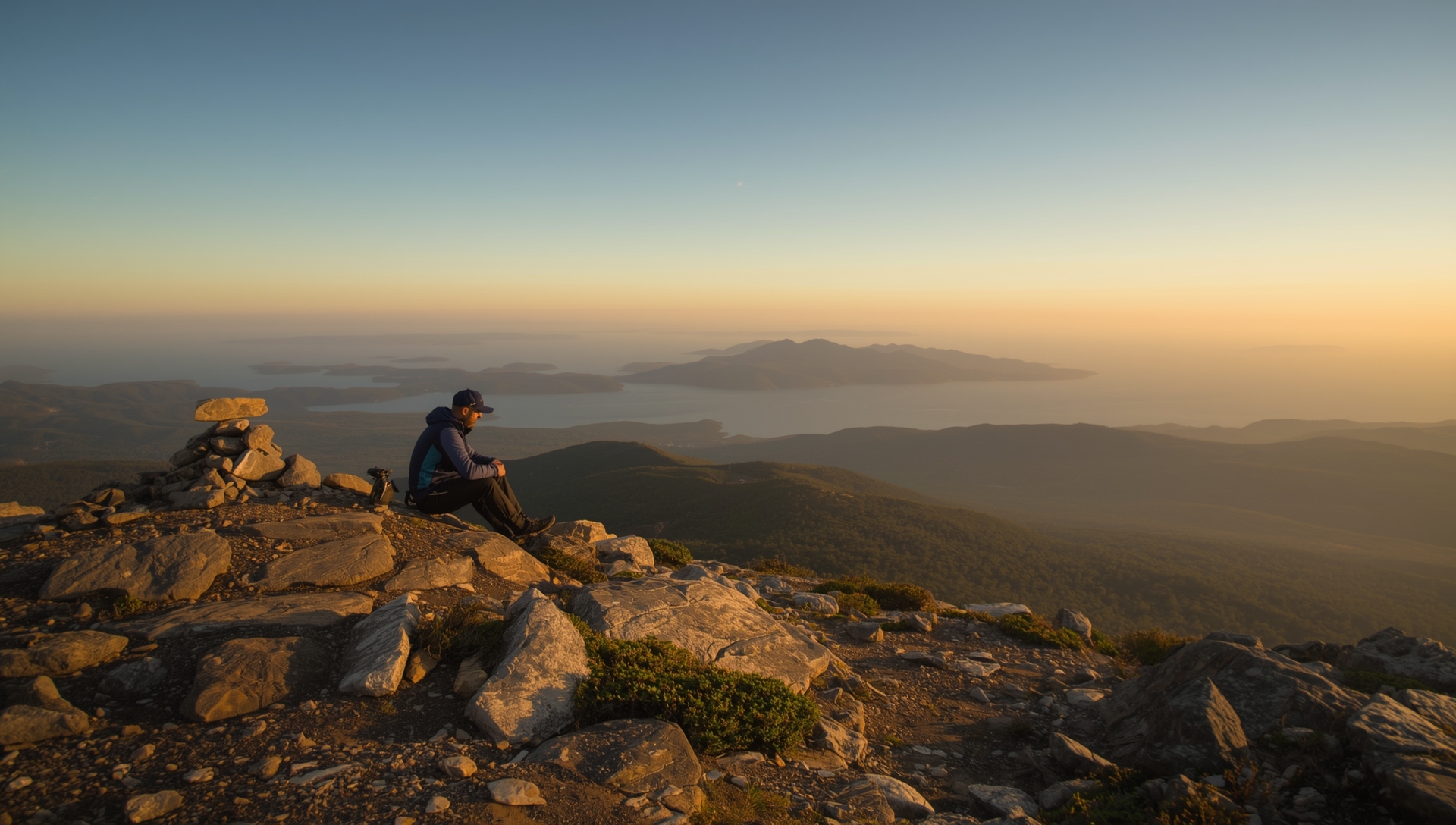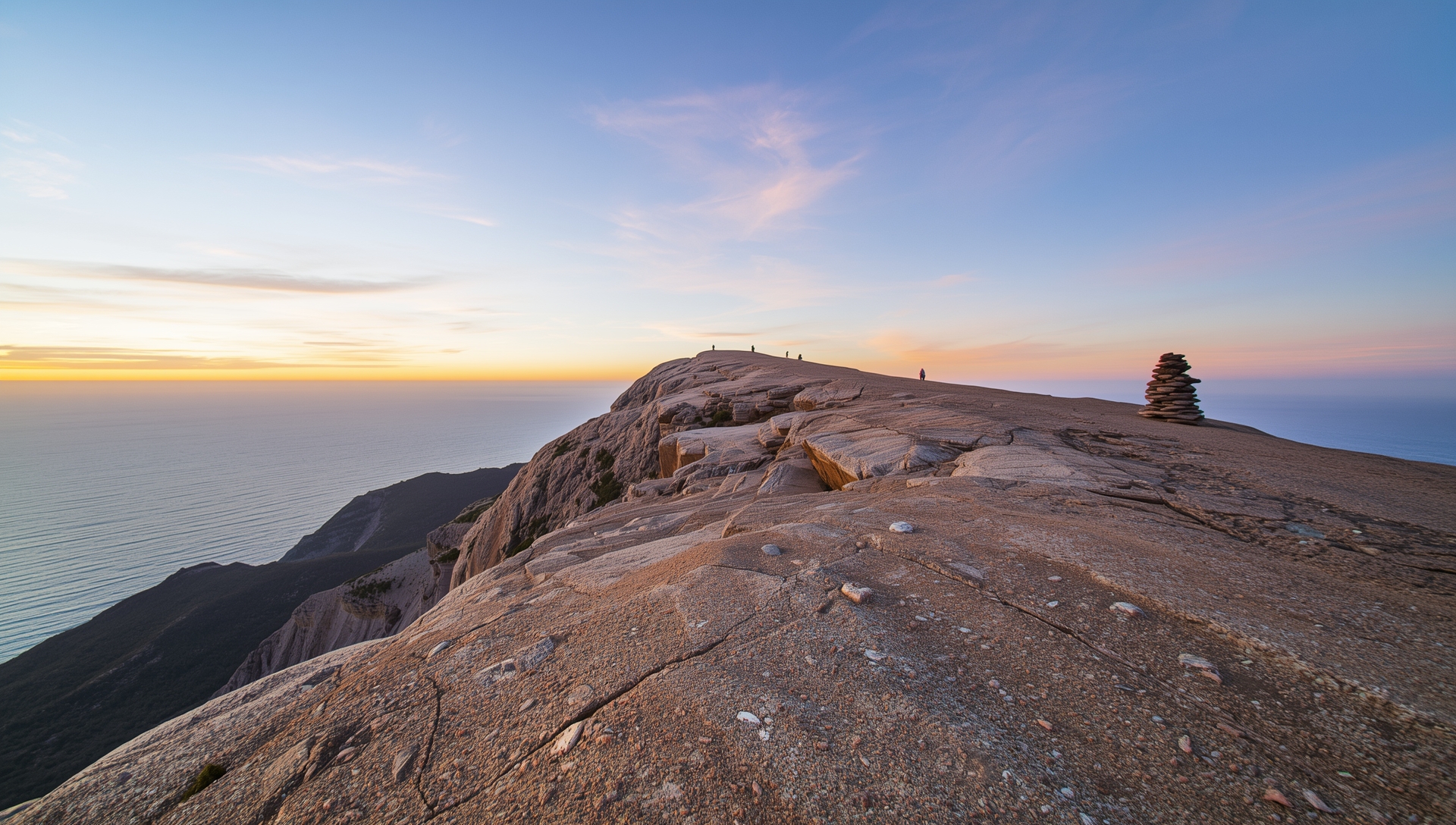Cadillac Mountain South Ridge Trail Acadia (Loop Path)
From Forest Floor to Granite Summit
The Cadillac Mountain South Ridge Trail is one of Acadia’s most rewarding and wide-open routes — a 6.7-mile round trip that climbs steadily from the quiet woods near Blackwoods Campground Acadia to the highest point along the U.S. Atlantic coast. The journey begins gently under a green canopy of pine, spruce, and birch. Roots tangle the path and morning mist settles low, carrying the scent of salt and forest. It’s a tranquil start, giving hikers a chance to find their rhythm before the landscape opens up and the real grandeur begins.
Soon, the forest gives way to bare granite ledges glowing pink in the sunlight. From here, the South Ridge Trail unfurls northward across Acadia’s stony spine. Every few steps reveal new angles — the blue expanse of Frenchman Bay, the silver curve of Otter Creek, and distant islands glinting in the light. The climb feels steady rather than steep, allowing time to pause and absorb the view while sea breezes sweep across the ridge.
As hikers approach the Featherbed, a small glacial tarn cradled in the rock, the air cools and the sound of wind replaces the rustle of trees. From this natural pause point, the final push to the summit stretches across open slabs of granite where cairns mark the way. Each one feels like a silent companion leading onward to Cadillac’s summit.
The South Ridge Trail offers everything Acadia is known for — shifting light, weathered rock, and vast horizons. It’s both a physical climb and a quiet, meditative passage through changing landscapes, from forest floor to mountain crown.
About the Cadillac South Ridge Trail
- Trail Overview: The Cadillac Mountain South Ridge Trail in Acadia National Park stretches 7.1 miles round trip, offering a gradual climb from forest to summit.
- Starting Point: Located across from Blackwoods Campground on Route 3 at the official Cadillac South Ridge Trailhead.
- Elevation Gain: Approximately 1,530 feet to the highest summit on the U.S. Atlantic coast.
- Terrain: Mix of shaded spruce forest, open pink granite ridges, and cairn-marked pathways.
- Highlights: Featherbed Pond, sweeping views of Frenchman Bay, and the Cadillac Summit Loop at the top.
- Trail Type: Out-and-back route ideal for a full-day hike with constant scenic rewards.
- Best Season: Late spring through early fall for the clearest skies and mildest conditions.
Trail Experience – Walking the Cadillac Mountain South Ridge Trail
The Cadillac Mountain South Ridge Trail is one of the most iconic long climbs in Acadia National Park — a route that unfolds gradually through forest, ridge, and open summit, showing the park’s beauty layer by layer. Beginning just across from Blackwoods Campground, the trail eases hikers in gently with a shaded walk through spruce and pine. The path is soft underfoot, carpeted in needles, and lined with moss-covered stones. Early in the morning, the air is still and cool, filled with the distant hush of ocean surf rolling against the cliffs below. It’s the kind of start that calms the mind before the mountain begins to rise.
After about half a mile, the landscape begins to change. The trees grow thinner, and sunlight filters through to reveal slabs of pink granite glowing under the canopy. The South Ridge Trail gradually opens onto a spine of exposed rock, offering the first real taste of what lies ahead — sweeping views that stretch from Otter Creek to the islands of Frenchman Bay. Each turn brings something new: the sparkle of water between the trees, a cluster of blueberry bushes clinging to stone, or the sudden appearance of a cairn marking the way forward. The higher you go, the more the air smells of salt and sun-warmed pine.
Unlike the steeper and shorter Cadillac North Ridge Trail, this southern route rewards endurance rather than speed. Its steady incline invites reflection — the kind of hike where you can hear your breath, feel your steps, and watch the scenery transform in real time. Along the midsection, the ridge widens and the ocean views dominate. It’s a wide-open world of rock and sky, punctuated by wind-bent evergreens and the rhythmic sound of your own footsteps on stone.
About halfway up lies the Featherbed, a small glacial tarn nestled in a basin of granite. This peaceful pond feels like a pause in the climb — a quiet mirror surrounded by shrubs, with dragonflies hovering above the surface and the reflection of clouds drifting lazily across it. It’s a perfect spot for a rest or photo before tackling the final push to the summit.
From here, the trail becomes more exposed, the terrain more rugged. Low alpine vegetation — crowberry, mountain ash, and stunted spruce — clings to the granite. Cairns line the route, guiding hikers along the natural contours of the ridge. The wind grows stronger, carrying the tang of sea air, and the views expand dramatically. Frenchman Bay spreads wide to the east, dotted with the Porcupine Islands. To the west, Eagle Lake and Jordan Pond shimmer like polished glass, reflecting the sky.
The final ascent is steady but not harsh. The granite surface rolls upward in gentle waves, giving a clear view of the summit dome ahead. By the time hikers reach the top, they’ve covered more than three miles and crossed nearly every type of Acadian terrain — forest, ridge, pond, and mountain crown. Standing there, surrounded by 360 degrees of sky and sea, the sense of accomplishment feels earned.
The Cadillac Mountain South Ridge Trail isn’t just a path to the summit; it’s a full narrative of the park’s natural rhythm. Every step reveals a new connection between land and ocean, every gust of wind a reminder of Acadia’s wild coastal heart. It’s a trail that embodies patience, persistence, and the quiet reward of walking through one of the most beautiful landscapes in Maine.
• Trail Name: Cadillac Mountain South Ridge Trail
• Length: 7.1 miles (11.4 km) round trip
• Elevation Gain: Approximately 1,530 ft (466 m)
• Difficulty: Moderate – steady climb on open granite ridges
• Trailhead: Across from Blackwoods Campground on Route 3
• Highlights: Featherbed Pond, cairn-marked ledges, and panoramic views of Frenchman Bay
• Best Time: Late spring through fall; sunrise and late afternoon light are ideal
• Tip: Carry plenty of water and sun protection — the upper ridge is fully exposed.
Trail Highlights & Nearby Spots
The Cadillac Mountain South Ridge Trail offers one of the most graceful ascents in all of Acadia. Every section feels thoughtfully composed by nature — a balance of forest, rock, and open air that unfolds naturally as you climb. The highlights come not in sudden bursts but as a gradual layering of views, colors, and textures that reveal the park’s beauty in quiet, breathtaking moments.
From the start near Blackwoods Campground, the atmosphere feels calm and secluded. Morning light filters through the canopy of spruce and pine, and the air carries a cool hint of ocean salt from the nearby coast. The forest floor is soft with needles and moss, muffling each step until the granite begins to rise. Soon, the trees thin, and the pink rock emerges beneath your boots — the first sign that the trail is about to open up. This transition from shaded woodland to exposed ridge is one of the most memorable parts of the journey, marking the beginning of Acadia’s grand coastal panorama.
Once on the ridge, the world expands in every direction. The granite glows with warm light, and the Atlantic stretches beyond the trees in shifting tones of silver and blue. Frenchman Bay shimmers to the east, its islands appearing and disappearing as the light changes. The ridge itself curves gently, rolling upward in waves of granite and low alpine vegetation. The contrast of stone and sea feels both raw and peaceful — an experience that defines the South Ridge Trail more than any single viewpoint ever could.
Further along, the trail dips briefly into a natural basin where the Featherbed sits nestled among the ledges. This small pond, formed by a glacier long ago, mirrors the sky and surrounding ridges, adding a quiet sense of reflection to the climb. Dragonflies skim across its surface, and the wind ripples the water in soft patterns. Many hikers pause here, not because they are tired, but because it feels impossible to pass such calm beauty without stopping to take it in. The moment you leave the Featherbed, the granite rises once again, leading toward the upper slopes of Cadillac Mountain.
The final stretch of the South Ridge Trail feels wide and endless. The forest has disappeared entirely now, replaced by lichen-stained stone, wind-bent shrubs, and far-reaching views. To the east, the sun reflects off the ocean in dazzling light; to the west, inland lakes glint between forested hills. As the summit draws near, the landscape feels almost otherworldly — open, glowing, and alive with movement. The cairns that guide the way seem to lead not just upward, but onward into the sky itself.
At the summit, the reward is not a single vantage point but a full circle of horizon. The sea, the forest, the islands, and the sky all merge into one vast expanse. This is the magic of the South Ridge: a trail that never rushes, never hides its treasures, and never loses its sense of calm. Each section blends into the next until you’ve crossed an entire mountain without ever feeling separated from the world around you.
• Scenic Character: Long, gradual ridge with constant ocean views and open granite slopes
• Standout Feature: The Featherbed — a small alpine pond surrounded by smooth granite ledges
• Atmosphere: Peaceful, airy, and panoramic, with shifting light over Frenchman Bay
• Best Vantage Points: Upper ridge before the summit and the final approach under early sunlight
• Trail Texture: Smooth pink granite, mossy patches, and occasional scrub pine for contrast
• Overall Impression: A steady, rewarding climb that captures Acadia’s essence — sea, stone, and sky in perfect balance
Trail Facts – Key Details About Cadillac Mountain South Ridge Trail
Among the many routes leading to the summit of Cadillac Mountain, the South Ridge Trail remains the most complete and rewarding journey. It is the trail that reveals the mountain’s character gradually — from shaded forest to wide-open granite ridge — offering hikers a tangible sense of elevation, distance, and time. This section brings together the essential facts and practical details that help define the experience while grounding it in the textures and features of the trail itself.
At 6.7 miles (10.8 km) round trip, the South Ridge Trail is Acadia’s longest continuous climb to the summit. It rises roughly 1,350 feet (411 m) from the trailhead just across from Blackwoods Campground on Route 3. Most hikers take between three and five hours to complete the return journey, depending on pace, weather, and time spent enjoying the views. While it’s rated as moderate to challenging, the challenge lies more in endurance than technical difficulty. The granite ledges can be uneven and occasionally slippery after rain, but the incline itself is steady and forgiving — a gradual climb rather than a scramble.
The trail is marked by classic Acadian cairns — small stone piles placed at intervals along the granite ridge. These guides are especially useful near the summit where the terrain opens wide and the path blends with the rock. It’s a good idea to bring a map or GPS reference, though the route is generally clear in good weather. The open exposure also means hikers should prepare for strong coastal winds and shifting temperatures, particularly in spring and autumn.
Water is limited along the trail, so it’s best to start with a full bottle, especially in summer. The Featherbed Pond, while beautiful, is not a source for drinking water. Sturdy footwear with traction is essential for the mix of forest soil, exposed stone, and occasional puddles that define the surface of the South Ridge Trail. Trekking poles can also help on the descent, as the gradual slope can be surprisingly tough on the knees after a long day.
For photography and light, early morning and late afternoon are ideal. The ridge faces east for most of its ascent, catching the glow of sunrise over Frenchman Bay. Later in the day, the light softens to gold, enhancing the granite’s pink hue and making the islands shimmer across the water. Wildlife sightings include black-capped chickadees, white-throated sparrows, and chipmunks that dart between cracks in the rock. In autumn, the ridge is surrounded by a brilliant contrast of red blueberry bushes and evergreen pines.
The South Ridge Trail is accessible by car or shuttle, with parking available near the Blackwoods Campground entrance. For those camping overnight, it’s an easy walk to the trailhead at dawn — a common ritual for hikers hoping to reach the summit in time for sunrise. In winter, the trail remains open but can be icy, and traction devices are recommended.
Every element of the South Ridge Trail — the distance, the light, the sound of the wind — reflects Acadia’s rhythm. It’s a hike that rewards steady movement, awareness, and respect for the mountain’s quiet power. Whether climbed as a personal challenge or a moment of reflection, the trail’s facts all point to one truth: the South Ridge is not simply a route upward but a journey through the essence of Acadia itself.
• Trail Length: 6.7 miles (10.8 km) round trip
• Elevation Gain: 1,350 ft (411 m)
• Average Hiking Time: 3–5 hours
• Difficulty: Moderate to challenging
• Trailhead: Across from Blackwoods Campground, Route 3
• Summit Elevation: 1,530 ft (466 m)
• Best Conditions: Spring through fall; sunrise and late afternoon for best light
• Trail Markers: Stone cairns on open granite sections
• Facilities: Limited; nearest restrooms at Blackwoods Campground
• Key Safety Tip: Carry plenty of water and check weather — wind and fog can change quickly
Trail Highlights & Nearby Spots
The Cadillac Mountain South Ridge Trail offers more than just a climb — it’s a constantly changing experience that reveals nearly every type of landscape Acadia National Park is known for. Beginning in the quiet woods across from Blackwoods Campground, the trail eases hikers in with a cool, shaded path lined with moss-covered rocks and spruce roots. The sound of distant surf drifts up from the coast, and in the still mornings, the light filters gently through the pine canopy. Before long, the forest begins to thin, and the terrain transitions to a mixture of bedrock and open ledges. This gradual unveiling is one of the trail’s greatest charms — every few hundred feet, another glimpse of the ocean teases what’s to come.
Soon, the granite ledges take over, stretching out in soft pink ribbons that seem to glow in the sun. These formations are some of Acadia’s oldest rock surfaces, sculpted by glaciers thousands of years ago. Hiking here feels like walking along the backbone of Mount Desert Island itself. Small cairns — stacks of stone built by rangers — guide your steps across the open expanse, marking the route without disrupting the wild beauty of the landscape. It’s easy to pause here, turn around, and marvel at how quickly the forest gives way to sweeping ocean views that reach far toward the horizon.
Roughly halfway up, the trail passes Featherbed Pond, a tranquil glacial basin nestled between two low ridges. The pond reflects the surrounding evergreens and often catches morning mist in its still waters. In summer, the shoreline blooms with wild blueberries and tiny alpine flowers, while in autumn, the surrounding brush turns brilliant orange and red. It’s a perfect place to stop for a break, listen to the soft wind, and appreciate just how peaceful this ridge can be.
As you climb beyond Featherbed Pond, the ridge narrows, the horizon expands, and the ocean takes center stage. The pink granite continues to rise in waves toward the summit, where the views grow increasingly dramatic. From here, you can see the Porcupine Islands scattered across Frenchman Bay, the Schoodic Peninsula Acadia National Park gleaming to the east, and the rounded peaks of Acadia rolling toward the west. Each shift in elevation brings a new perspective — a mosaic of forest, ocean, and sky that defines the park’s unique topography.
At the top, the trail joins the Cadillac Summit Loop Trail, a short circular path that highlights Acadia’s highest vantage point. The summit’s interpretive signs describe the geology and early explorers who first documented the area. On clear days, the sunrise from Cadillac Mountain is among the most famous in America — it’s often one of the first spots in the United States to catch the morning light. For those staying at Blackwoods Campground, hiking the South Ridge before dawn and reaching the top in time for sunrise is a bucket-list experience.
Descending the same way offers an entirely different mood. Afternoon light casts long shadows across the ledges, and the pink granite glows gold. Many hikers find that the descent feels meditative — a steady return from the clouds back to the forest floor, where the smell of pine and salt air mingles once again. Between the mountain’s sweeping panoramas, tranquil pond, and forested base, the South Ridge Trail gives you the complete essence of Acadia in one unforgettable hike.
Highlights Along the South Ridge
- Featherbed Pond: A tranquil glacial tarn reflecting the surrounding ridges.
- Granite Ledges: Broad pink stone slabs shaped by ancient glaciers.
- Trail Cairns: Iconic stone markers that guide hikers across the open ridge.
- Panoramic Views: Sweeping scenes of Frenchman Bay and the Porcupine Islands.
- Cadillac Summit Loop: A short scenic circuit with interpretive displays and photo lookouts.
- Blackwoods Campground: Convenient base for early starts and easy trail access.
- Best Time: Early morning for solitude or sunrise at the summit.
Nature & Wildlife Along the Trail
Nature reveals its subtler side along the Cadillac Mountain South Ridge Trail, where each stretch of elevation brings a shift in the plants, colors, and sounds around you. At the base, dense stands of spruce, fir, and pine enclose the trail in shadow and stillness. Fallen needles soften each step, and the air is heavy with the scent of resin and salt carried from the nearby Atlantic. This lower woodland is home to red squirrels, chickadees, and warblers that dart between branches, their calls echoing softly through the trees. Mushrooms cluster around decaying logs, while ferns thrive in the cool pockets of soil shaded from the sun.
As the path climbs higher, the vegetation thins and transitions into a mix of blueberry scrub, alpine grasses, and stunted evergreens. The wind begins to carry the cry of gulls and the faint rustle of dry leaves. This zone between forest and ridge is one of Acadia’s most delicate ecosystems — shaped by centuries of wind, frost, and salt spray that limit the growth of taller trees. The result is a carpet of hardy vegetation: reindeer lichen, crowberry, and low-lying juniper that color the granite in greens and silvers. In late summer, wild blueberries add flashes of blue along the trail, attracting small birds and chipmunks who scurry between rocks in search of fruit.
By the time hikers reach the open ledges, the environment feels almost alpine. The exposed granite and thin soils create a habitat for species adapted to extremes — plants that can withstand heat, cold, and constant wind. Look closely, and you’ll see mountain sandwort, cinquefoil, and sedge tucked into crevices where water collects after rain. These plants cling stubbornly to life, anchoring Acadia’s rocky ridges and preventing erosion. The terrain might appear barren from a distance, but up close, it’s full of intricate detail — each patch of moss, each spray of lichen, forming a miniature ecosystem.
Wildlife on the South Ridge is equally varied. White-tailed deer sometimes cross the upper trail near dawn or dusk, moving quietly between thickets of spruce and mountain ash. Along the granite slopes, ravens and turkey vultures circle overhead, riding the thermals rising from the sun-warmed rock. On clear mornings, peregrine falcons — successfully reintroduced to Acadia — may be seen gliding along the cliffs. Closer to the summit, small pollinators hum among the sparse flowers, their resilience a quiet reminder of how life adapts even in harsh, wind-exposed environments.
What makes this trail remarkable is how visibly Acadia’s ecosystems shift over just a few miles. The base feels coastal and sheltered, the midsection alpine and wind-swept, and the summit — with its lichens, moss, and stunted pines — carries the stark beauty of the far north. Each layer supports its own rhythms of life, woven together by the slow processes of geology and climate that have shaped Cadillac Mountain over millennia. For anyone hiking the South Ridge, it’s not just a climb — it’s a lesson in endurance and adaptation, played out across one of the most diverse landscapes in the park.
Flora & Fauna of the South Ridge Trail
- Forest Base: Spruce, pine, and fir trees shelter red squirrels, chickadees, and warblers.
- Mid-Ridge Zone: Blueberry bushes, juniper, and reindeer lichen thrive on thin, rocky soils.
- Alpine Ledges: Hardy plants such as mountain sandwort and cinquefoil cling to granite crevices.
- Wildlife: White-tailed deer, peregrine falcons, and ravens are often sighted near open ridges.
- Seasonal Blooms: Wildflowers and mosses brighten the ridge through late spring and early summer.
- Ecological Significance: Each elevation layer reveals Acadia’s remarkable environmental diversity.
Seasons on the Trail
Every season transforms the Cadillac Mountain South Ridge Trail into a completely different experience — a living rhythm of weather, light, and life unique to Acadia National Park. Whether blanketed in snow, lined with new spring leaves, or bathed in warm golden light, this ridge never feels the same twice. The changing seasons are as much a part of the trail’s character as its granite and wind.
Acadia in spring arrives slowly on Cadillac Mountain. Snow lingers on the shaded ledges, and the first signs of green emerge in April when mosses and ferns reawaken from the cold. Small streams trickle across the lower trail near the South Ridge Trailhead, and the air carries a scent of pine and wet stone. Hikers might spot white-throated sparrows and warblers returning from migration, their calls mingling with the sound of water dripping from thawing snow. The path can be damp underfoot, but the crisp air and the sight of buds opening on spruce branches make spring one of the most rewarding times to experience the park in peace.
Acadia National Park in summer sees the trail alive with color and warmth. Blueberry bushes thrive along the ledges, their fruit ripening under the long daylight hours. The Cadillac South Ridge Trail becomes a corridor of life — chipmunks dart between rocks, dragonflies circle Featherbed Pond, and the faint hum of bees rises from the wildflowers that cling to the granite. The open ridge catches every breeze, making even warm days feel comfortable. Morning hikers often climb into fog that burns off by midmorning, revealing the deep blue of Frenchman Bay and the distant Schoodic Peninsula. Long days allow for late-afternoon ascents and glowing sunsets from the summit before the stars begin to appear.
Acadia in the fall brings a spectacular shift in color and mood. The South Ridge Trail becomes one of the most stunning fall hikes in Acadia, with the forest below bursting into orange, red, and gold. From the granite ledges, the view of Mount Desert Island’s valleys looks like a quilt of color stretching to the sea. Cooler temperatures and fewer crowds make it ideal for long, quiet climbs. The crisp air sharpens every sound — leaves underfoot, the whistle of the wind, and the occasional distant call of a raven circling above the ridge.
Acadia National Park winter, though more challenging, reveals the trail at its most tranquil. The Cadillac Mountain South Ridge Trail is open year-round, and adventurous hikers or snowshoers often find it empty and serene. The granite ledges are softened under snow, and ice crystals sparkle in the morning sun. Animal tracks crisscross the lower path — fox, hare, and even deer venturing across frozen patches. The views from the top are stark and beautiful: bare forests below, the ocean dark and still, and the horizon etched against a pale sky. For those who prepare properly, it’s a rare way to experience Acadia’s solitude and power in its rawest form.
Each season carries its own invitation. Spring offers renewal, summer abundance, autumn brilliance, and winter silence. Together they tell the story of a mountain that never stops changing — a reminder that even the most familiar trail is different every time you walk it.
Best Time to Hike the South Ridge Trail
- Spring: Cool temperatures, wildflowers, and migrating birds returning to the ridge.
- Summer: Blueberry season, long daylight hours, and clear coastal views.
- Autumn: Brilliant foliage, comfortable weather, and fewer crowds on the trail.
- Winter: Quiet, snow-covered paths and rare solitude for well-prepared hikers.
- Best Overall Months: June through October provide the most stable weather and fully accessible terrain.
Planning Your Visit
Planning your hike on the Cadillac Mountain South Ridge Trail is about more than just lacing up your boots — it’s about preparing for one of the most rewarding long routes in Acadia National Park. Stretching approximately 7.1 miles round trip, this trail combines forest paths, granite ridges, and spectacular views all the way to the summit of Cadillac Mountain, the highest point on the eastern seaboard. A little planning goes a long way to make the experience safe, smooth, and unforgettable.
The South Ridge Trailhead begins across from Blackwoods Campground Acadia along Route 3, just a short drive from Bar Harbor. Because this section of the park is popular in every season, parking fills quickly — especially on sunny weekends. The best strategy is to arrive early, ideally before 8:00 a.m., to secure a spot and enjoy the quieter atmosphere before the trail becomes busy. Those camping at Blackwoods can start right from their site, making this one of the most convenient access points for an early climb.
The ascent follows a steady but manageable grade. The lower mile winds through a cool forest of spruce, fir, and pine before opening gradually onto the granite ridges that make this trail so distinctive. Although the slope never feels overly steep, the hike is long, and exposure to wind and sun increases as you gain elevation. Layered clothing, sun protection, and at least two liters of water per person are essentials, even outside of summer. The granite reflects light and heat, and the lack of shade near the top can make conditions deceptively warm on clear days.
Because of its length and exposure, it’s wise to check the weather forecast before setting out. The South Ridge can be breezy, foggy, or slick with moisture even when conditions at sea level look fine. The National Park Service frequently updates local forecasts and trail status online — a quick check can help you avoid unexpected rain or reduced visibility. During winter and early spring, microspikes or traction cleats are strongly recommended, as ice often lingers in shaded areas long after snow has melted elsewhere.
The trail is well-marked with stone cairns and blue paint blazes, an iconic feature of Acadia’s historic trail system. These small pyramids of stacked rock serve as navigation aids, guiding hikers across the open granite slabs. It’s important to leave these markers untouched; the park carefully maintains them to preserve the trail’s original routes. Carrying a printed map or downloading an offline trail map through the NPS app is also a good practice, as phone reception can fade along the ridge.
At the summit, hikers can extend their experience by completing the Cadillac Summit Loop Trail, a short circular route that passes interpretive signs, overlooks, and rock pools filled with rainwater. This adds roughly half a mile but offers panoramic views of Frenchman Bay, Schoodic Peninsula, and the scattered islands that define Acadia’s rugged coastline. Those preferring a shorter descent can arrange a pickup at the summit parking area when the Cadillac Summit Road is open (typically mid-May through mid-October).
Descending via the same trail allows time to appreciate the changing light and terrain — from the open granite ridge back to the peaceful forest floor. As shadows lengthen across the granite, the golden tones of afternoon light give the entire ridge a serene glow, especially near Featherbed Pond. The Cadillac Mountain South Ridge Trail rewards hikers who pace themselves, plan carefully, and embrace the full rhythm of the mountain. With its combination of accessibility, challenge, and sweeping beauty, it remains one of Acadia National Park’s most classic and unforgettable hikes.
Trail Prep Essentials
- Distance: 7.1 miles round trip (moderate to strenuous)
- Elevation Gain: Approximately 1,350 feet
- Trailhead: Across from Blackwoods Campground on Route 3
- Best Months: June through October for ideal weather
- Facilities: None along the trail — bring water and snacks
- Navigation: Marked with cairns and blue blazes — do not move cairns
- Gear: Sturdy boots, layered clothing, microspikes in winter
- Safety Tip: Check NPS trail updates before departure
- Optional Add-On: Cadillac Summit Loop for panoramic views
- Time Estimate: 4–6 hours round trip, depending on pace
Reflect & Explore More
Every hike along the Cadillac Mountain South Ridge Trail feels like a small journey through Acadia’s soul. From the stillness of the lower forest to the wind-swept granite near the summit, this trail captures what makes the park so special — its raw mix of beauty, challenge, and quiet reflection. Even after the final step back to the trailhead, most hikers carry a sense of calm that lingers long after leaving the mountain.
At sunrise, the ridge glows pale gold, and the view over Frenchman Bay stretches endlessly toward the Atlantic. By afternoon, the pink granite radiates warmth underfoot, and the soft sound of wind across the ledges fills the silence. In every direction lies a reminder of Acadia’s balance between land and sea, strength and serenity. The trail invites both motion and pause — the climb that clears the mind, and the summit that fills it with wonder.
Whether you’ve reached the top for sunrise, traced the cairns under a bright summer sky, or walked the quiet path through winter snow, the South Ridge Trail becomes more than a route — it’s a rhythm you move with. The steady rise of the ridge mirrors Acadia’s own enduring heartbeat, one that’s felt in every gust of coastal wind and every shimmer of light across the granite.
For those exploring further, nearby trails such as the Cadillac North Ridge Trail, Beehive Trail Acadia, and Jordan Pond Trail Acadia reveal new perspectives on the same vast landscape. Each connects back to this shared thread — Acadia’s timeless ability to make you slow down, look closer, and rediscover the beauty of the natural world.
Why Hike the Cadillac South Ridge Trail
- Longest Route to the Summit: The 7.1-mile round trip South Ridge Trail offers the most scenic and rewarding climb up Cadillac Mountain.
- Panoramic Views: From Frenchman Bay to the Porcupine Islands, this trail provides Acadia’s broadest coastal vistas.
- Natural Highlights: Walk from dense spruce forest to open pink granite ledges, passing Featherbed Pond and cairn-marked ridges along the way.
- Ideal Trailhead: Begin directly from Blackwoods Campground or Route 3 for easy early-morning access.
- Linked Experiences: Connect to the Cadillac Summit Loop for interpretive signs and 360° views at the top.
- All-Season Adventure: Open year-round for hiking, snowshoeing, or photography — a true Acadia classic in every season.
Every step along the South Ridge leaves a lasting impression — the still forests, open granite, and quiet light of Acadia’s coast.
Take a moment to reflect, then return to explore more of Cadillac’s connected paths and panoramic viewpoints.
Your next favorite trail might be just around the bend.
Back to Cadillac Mountain TrailsExpand your Acadia knowledge and explore official hiking insights from trusted sources before your next summit adventure.
- National Park Service – Acadia National Park: Official park details, trail conditions, and visitor alerts directly from the NPS.
- NPS Hiking Guide for Acadia: Complete trail maps, safety tips, and seasonal recommendations for Acadia hikers.
- AllTrails – Cadillac Mountain South Ridge Trail: Community reviews, recent photos, and route stats from fellow hikers.
Love exploring America’s national parks and scenic trails?
Stay inspired with stories, trail updates, and hidden gems from coast to coast — straight to your inbox.
Join thousands of fellow adventurers who never stop exploring.
Sign Up